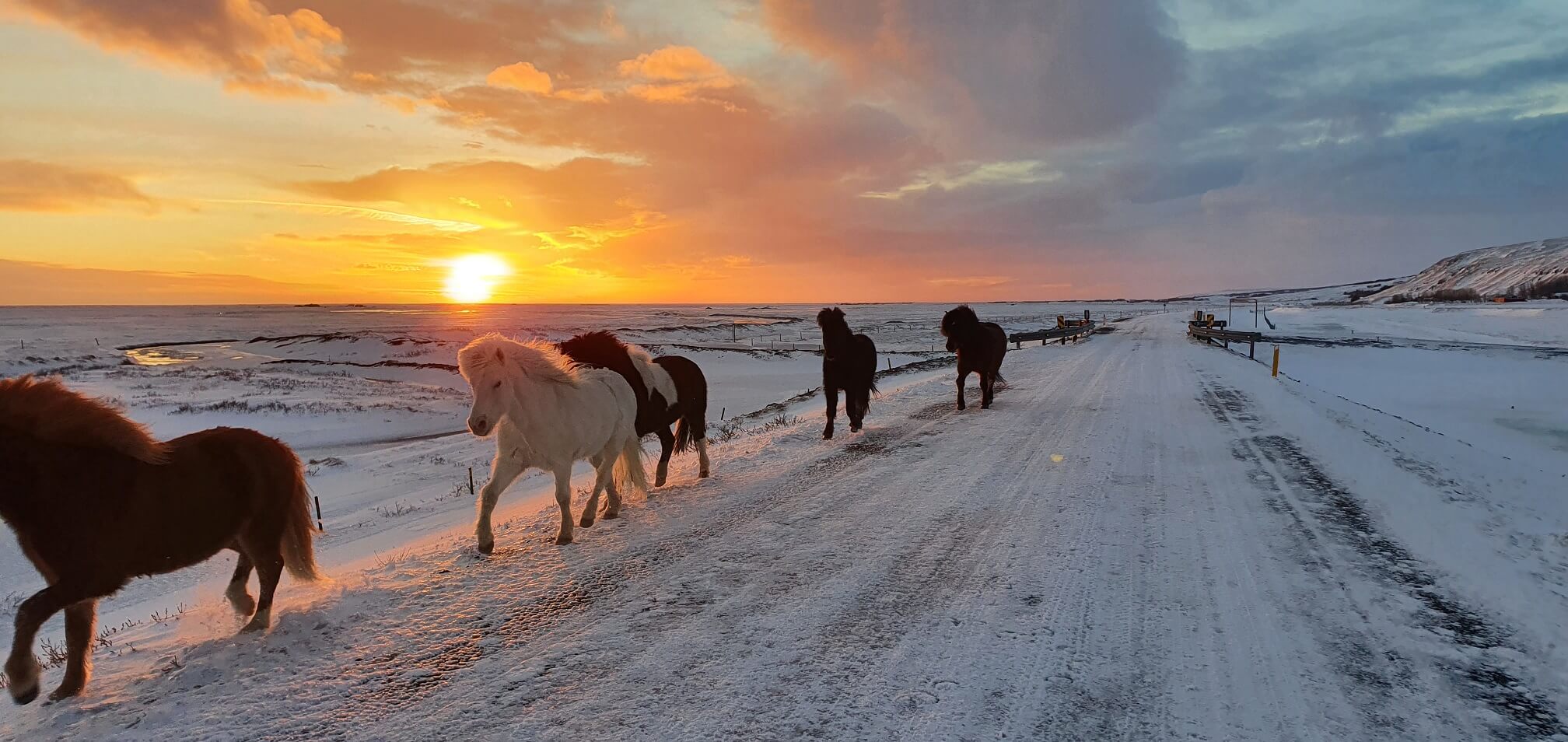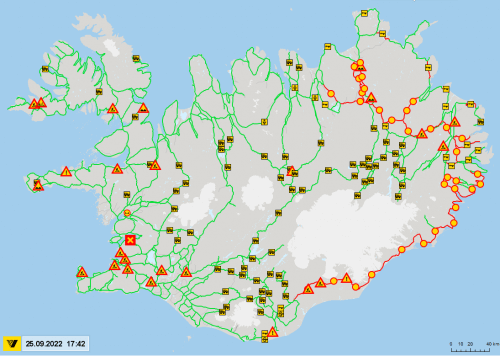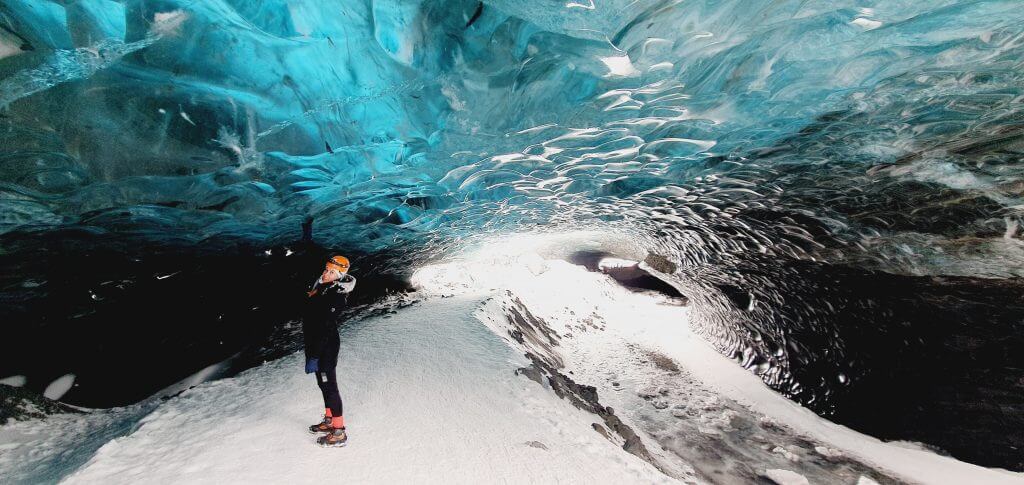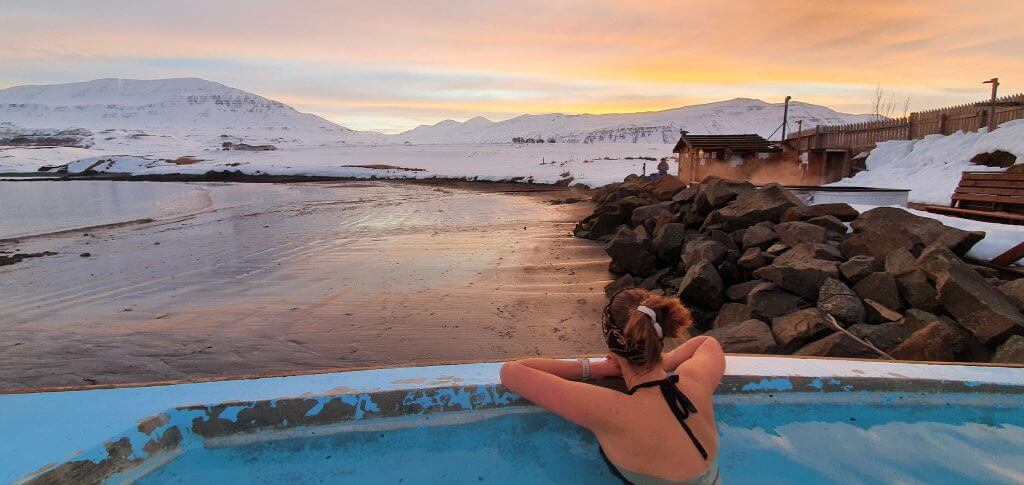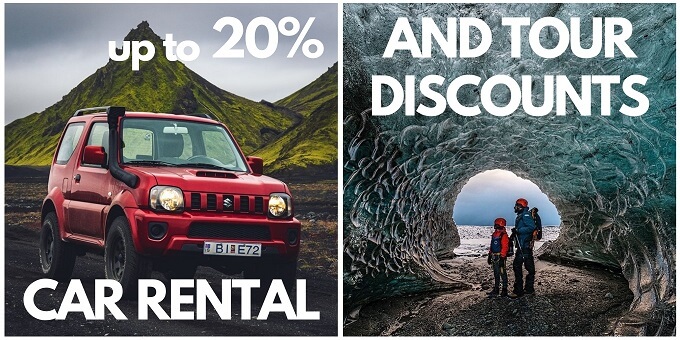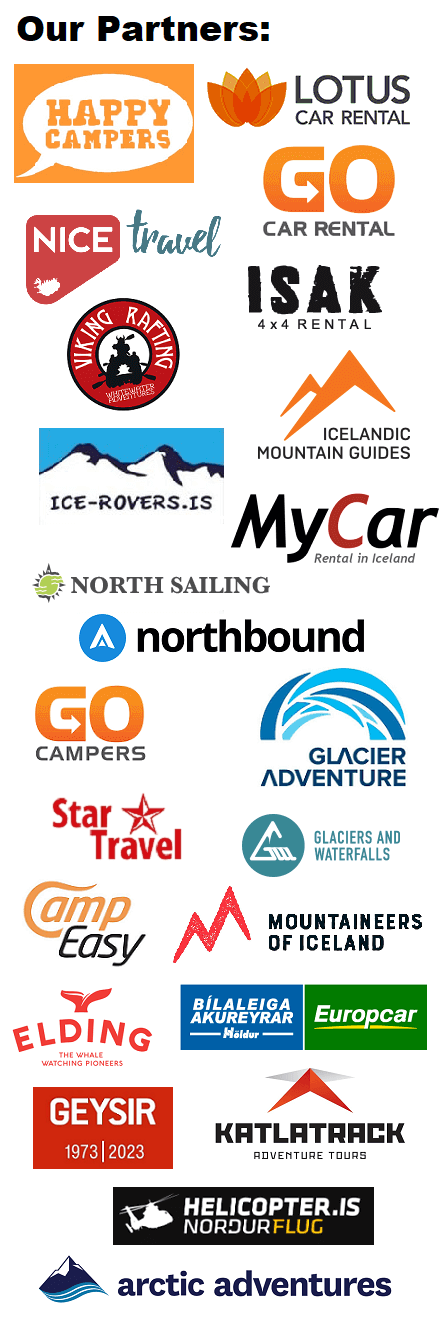Iceland in winter is very specific and you need to both prepare well and set your expectations right. We’ve put together a list of all important nuances you should prepare for when visiting Iceland in winter.
This post is part of our Winter Iceland articles series:
- South Iceland – best winter places
- East Iceland – best winter places
- North Iceland – best winter places
- Snæfellsnes – best winter places
- Winter Icelandic Itinerary
- How to see Northern Lights in Iceland
- Best Winter tours in Iceland
Contents
- 1. Quick tips for Iceland in Winter
- 2. Winter weather in Iceland
- 3. What to check before heading out
- 4. What month is the best to visit in winter?
- 5. Planning the accommodations in winter in Iceland
- 6. Essential clothes for winter Iceland
- 7. Icelandic Roads in winter
- 8. Car rental in winter
- 9. Flights to Iceland in winter
- 10. Northern lights
- 11. Hiking in winter in Iceland
- 12. Tourists
1. Quick tips for Iceland in Winter
- Be flexible. Weather may entirely change your plans for the day. Tours may get cancelled. Roads can get closed. Flight schedules can change pretty often too. Be mentally ready for that.
- Plan shorter days. It will take you longer to hike. It will take you longer to drive. It will take you longer to change the clothes. Weather alert may even squeeze your day into 2 hours only.
- Drive carefully. And choose a proper car. Driving on icy roads is no joke. But it’s doable if you drive with respect, caution and practice gradually. Watch www.road.is daily.
- Don’t underestimate. Wind, ice, driving, weather alerts, dark days. It may not end up well.
- Dress accordingly. It’s not that cold, but it’s very windy, it may rain and snow. No jeans.
- Bring shoe spikes. Or buy them once you arrive. It’s very icy on every hike. It’s Iceland.
- Set your expectations right. Read this article for many more tips 🙂
- Enjoy Iceland!! No matter the weather or your plans, Iceland will be amazing!
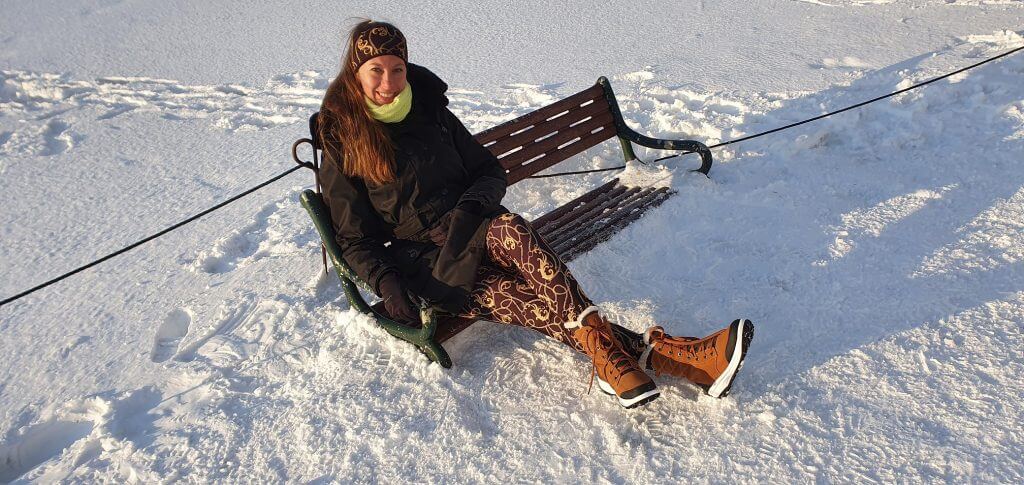
Winter in Iceland
2. Winter weather in Iceland
Want a real life example of what the weather in Iceland is like in winter? Last time we visited Iceland for 2 weeks at the end of February / beginning of March, we experienced the following weather:
- 3 days with weather alerts (strong winds and rain) – two of them on the days of our flights (yes, flights were postponed)
- 2 days with sun, clear skies and no wind
- 2 days with sun, clear skies and very strong wind
- 2 cloudy and windy days
- 1 rainy and foggy day
- 4-5 days with the mixture of all of the above in one day
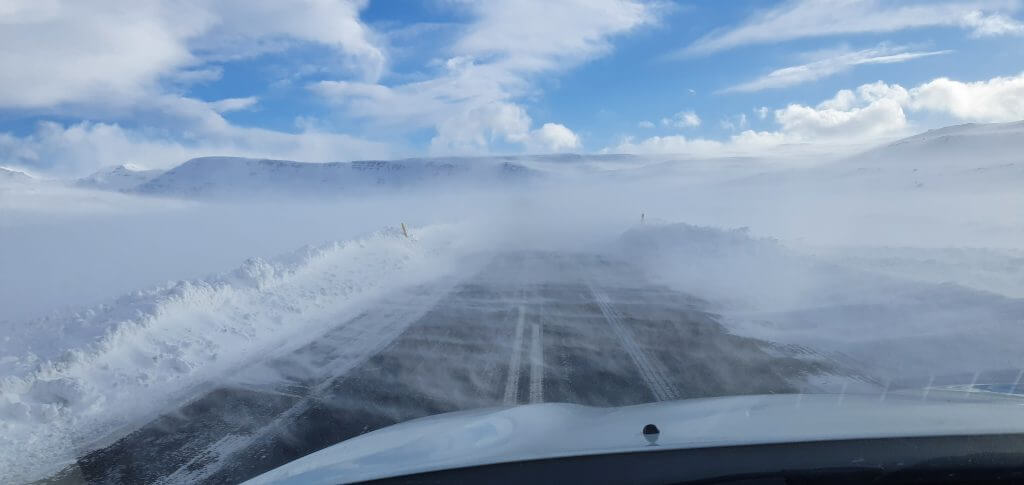
Road to Seyðisfjörður in winter
2.1. Winter temperatures in Iceland
It’s actually not so cold in Iceland in winter as you might expect. In February, we had days ranging from -5°C (i.e. 23°F) to +8°C (i.e. 46°F). The ocean warms up the coastal areas (i.e. basically almost the entire ring road), so it’s never -20°C in here. It can be that cold in the highlands, though. But you probably aren’t going to Icelandic highlands in winter, unless on a tour or unless you have some Icelandic friends with super jeeps 🙂
2.2. What is the weather like in Iceland in winter?
Expect a wild and unpredictable mixture of sunny days with blue skies, rainy days (yes, rainy!), cloudy days, windy days, snowy days and a mixture of those and anything in between and all of that sometimes changing even several times during the day.
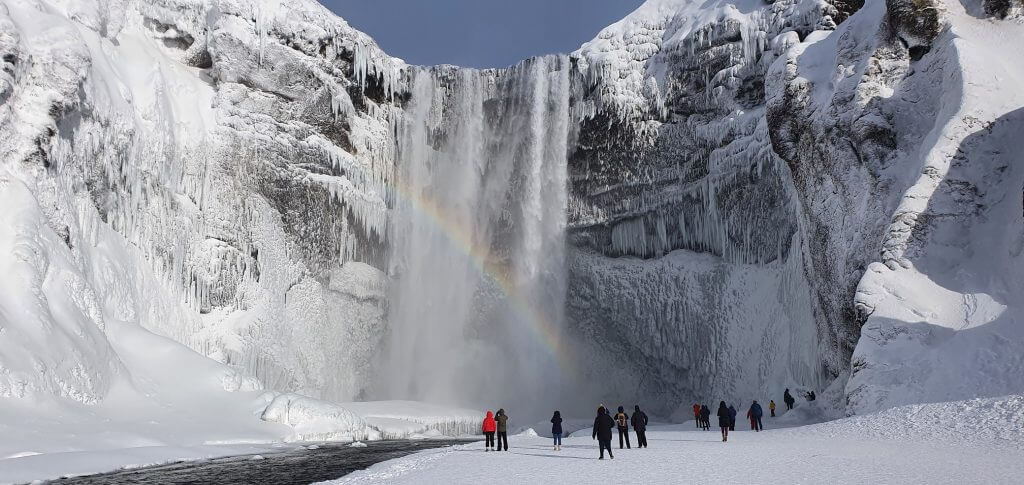
Wind blowing famous Skógafoss to the left
2.3. Wind in winter
Expect wind. A lot of it. Expect it to be strong, usually stronger than you are used to. It is not the cold, nor the rain/snow that may interrupt your plans, most of the time it is the strong wind, that, simply occurs every now and then during the winter. And it often causes weather alerts. Both our inbound and outbound flights in February/March were postponed due to strong winds by 8 hours and 2 hours respectively. Some airlines rather cancel the flights, see section on flights below.
2.4. Weather alerts
Related to the wind are the so called weather alerts. This usually means a very strong wind, sometimes combined with rain and/or snow. Wind may reach a hurricane force speed. No, you don’t want to drive or hike, or even walk outside when this kind of wind blows! There are three types of weather alerts – yellow, orange and red.

This is how you may end up driving in a weather alert. Source: www.ruv.is
- Red is the worst, as you probably suspected. Stay in a safe, indoor place under all circumstances
- Orange is the next, don’t drive in the orange alert. It may be possible to drive some really short distances but expect strong wind blows and usually wet and slippery roads. An ideal recipe for an accident. So, better don’t drive at all.
- Yellow alert is the least bad, but still pretty uncomfortable. And dangerous. Drive only when necessary and only short distances. Expect strong wind blows and usually also wet and slippery roads, just not that much as with the orange alert. Don’t drive through mountain passes at all (e.g. to Seyðisfjörður). Don’t plan any hikes. You can try walking outside but it won’t be very comfortable.

An ugly storm may make streets look like this for a while. Source: www.ruv.is
All alerts are much more bearable in cities. So, if you are staying in Reykjavik or Akureyri, you may try having a walk in yellow or even orange alert and see how it goes. Never in a red alert. Usually, you will want to avoid areas with any kind of alert, because neither driving, nor staying outside is very pleasant, and may actually even be dangerous. Things may be flying in the air during orange and red alerts.
3. What to check before heading out
Every day, before heading out, check the:
- Official Icelandic Meteorological website en.vedur.is for weather and weather alerts.
- Official Icelandic Road Administration website www.road.is for current road conditions. Roads may easily get closed or impassable in winter in Iceland. See the section about roads below.
- www.safetravel.is just to be sure you haven’t missed any alert or warning

Wind playing with horses’ hair. One of our favorite shots.
4. What month is the best to visit in winter?
Everybody has different priorities. You, and only you need to choose based on your priorities. You will never get everything 🙂 Every month in Iceland has some advantages and some disadvantages.
How to see Aurora in Iceland? A full guide to Northern Lights in Iceland
4.1. Best month in Iceland daylight-wise
When it comes to daylight hours, the closer you get to December, the shorter the daylight hours. This, on one hand, means much shorter days for any tours, hikes or sightseeing. On the other hand, this means higher chances for observing Northern Lights. Moreover, if you want to experience a fairy-tale-like Iceland full of snow, your chances are again higher the closer you get to December.
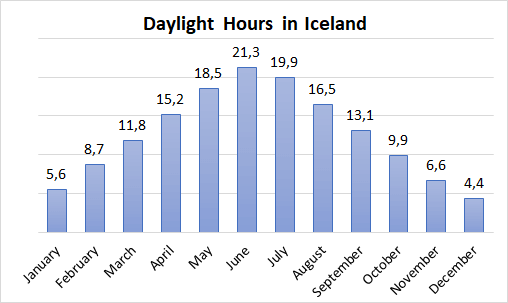
Daylight hours in Iceland by month
A good compromise may be months like October, February, or March, when there’s still enough daylight, but also dark enough skies for northern lights and most likely also snowy surroundings.
4.2. Best month in Iceland weather-wise
Weather-wise – you cannot predict it. It’s different each year. It’s impossible to say whether March has better weather compared to December or anything like that. The same applies to weather alerts. There are years and months when they don’t happen at all and then you have a week with 3 weather alerts. Get used to it. It’s part of traveling to Iceland in winter.
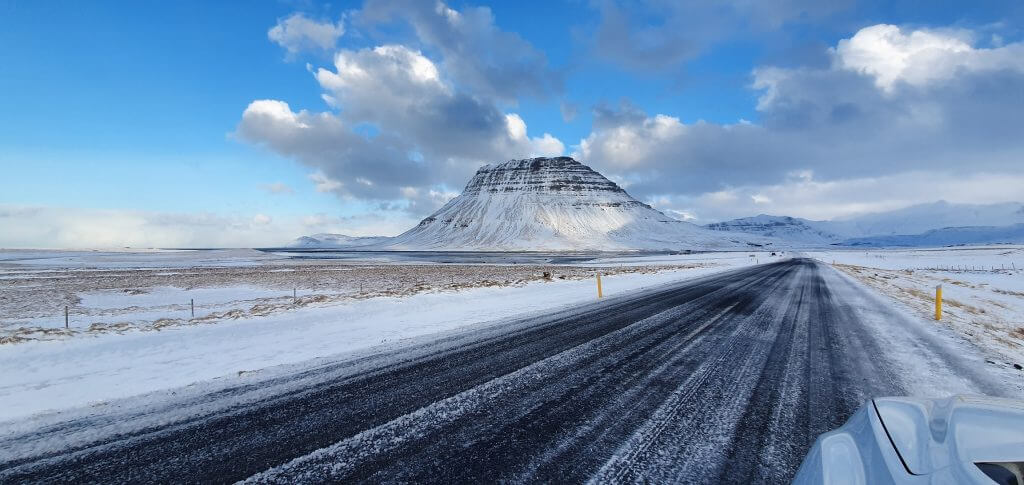
Clear skies in Iceland in March, next to Kirkjufell
Generally, weather is slightly more stable around September, March, or April. But, these are already kind of autumn/spring months, not exactly winter ones like November, December, January and February. October is often a good balance of chances for northern lights, still warm enough weather, less tourists and cheap prices, however there are often storms and weather alerts.
4.3. Best month in Iceland northern lights-wise
The shortest answer is between September and April. You need to balance good weather with dark skies. The best balance seems to be somewhere around September/October and then March/April. No guarantees, due to unpredictable weather. The drawback of these months may be less snow. Also, I suggest you read our Detailed Guide to Northern Lights to understand what are your chances to see Northern Lights and how to maximize them.
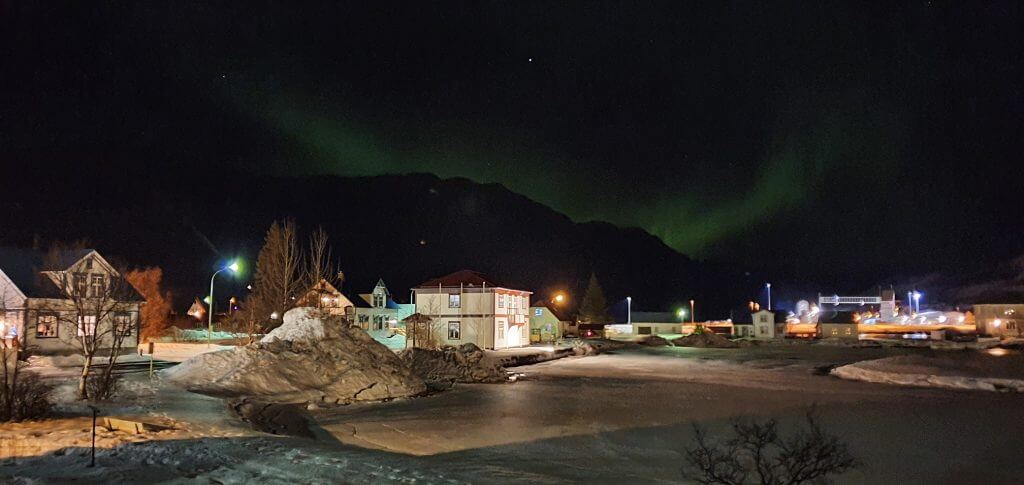
Our first Aurora “show” in Seyðisfjörður. Shot by simple cell phone.
4.4. Best month in Iceland snow-wise
Many visitors come to Iceland to experience a winter full of snow. If you come between November and February, you will most likely have a lot of snow everywhere. As we mentioned above, the more you head into central Iceland, away from the coast, the more snow you will see. Pretty often, you will experience snow also anytime from October until April, though not always. For example, on one occasion we visited Iceland at the end of February/beginning of March and there was almost no snow at the coastal areas. Temperatures reached up to +8°C (i.e. 46°F) and it rained, instead of snow.
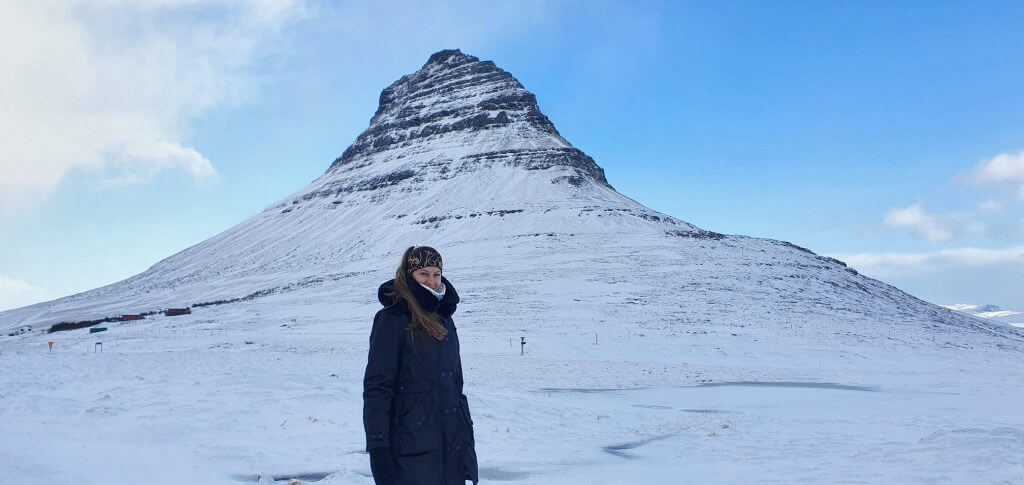
Kirkjufell in winter covered by snow
4.5. Best month in Iceland for Ice Caves
Oh and Ice caves! They are usually open from sometimes in October until sometimes in April. They change in shape and accessibility as the ice freezes or melts, with the peak ranging from November to March. These are the months when all of the ice caves are usually fully accessible. The most beautiful ice cave is usually the “crystal blue ice cave” near Jökulsárlón. You can visit ice caves only with guided tours, because it’s dangerous to go there alone. Once too much of snow and ice melts around end of April, most of the ice caves become too dangerous to visit and only some less (but still) beautiful ice caves stay open, like Katla ice cave.
A PROMO CODE EPICICELAND will get you a 5% discount with Local Guide of Vatnajökull, (in our opinion) the best Ice Cave and Glacier tour company.
5. Planning the accommodations in winter in Iceland
Accommodations very rarely get fully booked in winter in Iceland. By fully booked I mean all of the accommodations in some area. Yes, if you really want to stay in this particular hotel or cabin, that particular one may easily get fully booked, of course. But chances are, you will find a different accommodation option pretty easily, just not such a great one, maybe.
5.1. Last minute bookings
As I pointed out above, one of the options is to book accommodations “last minute”. This is pretty doable in winter. Worst case, you will need to drive an hour (or less) to reach the next free accommodation.

Yes, 4×4 car may be very useful in winter in Iceland
5.2. Flexible bookings in advance
The second option involves booking everything in advance, with 3 (or less) days cancellation option. This is what we prefer. 3 days upfront you are often able to tell whether you will be able to reach your accommodation or not. But it takes time to manage it, of course.
5.3. Fixed bookings in advance
The third option is to book everything without the cancellation option. In this case, I do recommend not booking the places too far from each other. For example, not farther than a 2-3 hour drive, or the drive you can make even in bad weather, worst case in the yellow alert. In case of a weather alert, you can always call your accommodation and try to arrange for an adjustment. Trust me, Icelanders are used to weather alerts.
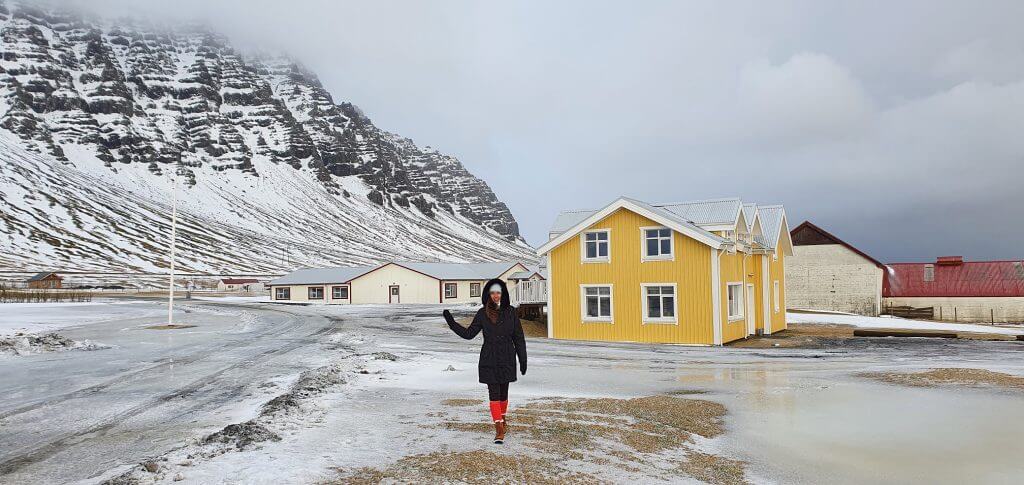
Picturesque houses in Hali
5.4. Campervans and Camping
The fourth option is booking a campervan, motorhome or for the most adventurous ones camping in tents. This is the least comfortable option, because Iceland can be pretty harsh in winter. But it’s definitely adventurous and often also cheaper. The important thing is – it is mandatory to stay in the designated campsites only, especially in winter. And only some campsites are opened in winter, check it before going!
We offer to our readers a 5% PROMO CODE for Go Campers rental.
5.5. Which campsites in Iceland are open in Winter?
To make it more challenging for you, there is no accurate, up to date list of Icelandic campsites that are open in winter. Campsites themselves make it harder for visitors, because every now and then some of them close and some of them open in winter. I highly suggest you call/write the campsite in advance to check whether the campsite is open around the time of your visit. Below are some useful sources that have tried to list campsites opened in winter in Iceland:
Secondly, bear in mind that even if the campsite is open, not all amenities may be in operation in winter. Some campsites operate as normally, while other ones close their kitchen areas and/or even showers and offer only a space for a tent. Check this by contacting the campsite.
6. Essential clothes for winter Iceland
What I brought and it was fully sufficient for a 2-week trip in February:
- pair of waterproof hiking boots with ankle support and anti-slippery rubber outsoles (like Vibram); ideally also insulated/winter ones
- 2 lower layers – base one (wool or synthetic), and the outer one (water and windproof pants)
- 3 upper layers – base one (wool or synthetic), middle one (fleece), and the outer one (water and windproof jacket with a hood)
- 1 pair of waterproof gloves, 1 woolen hat, 1 thicker balaclava, sunglasses and shoe covers to not let the snow get into your shoes from above
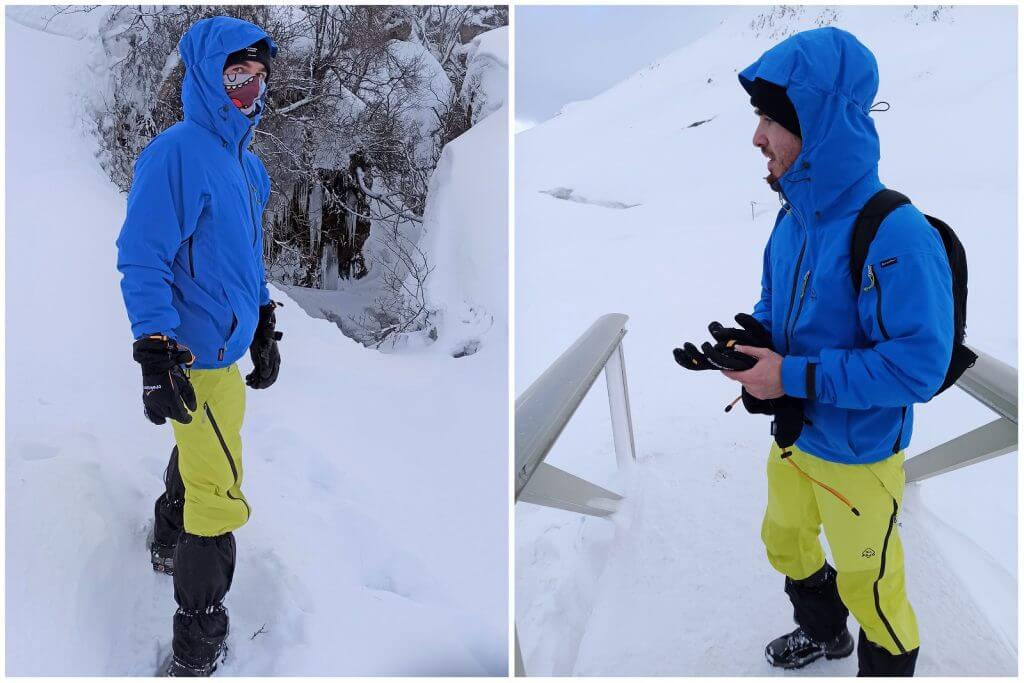
My winter “gear” for Iceland
My wife brought the same clothes, just one additional lower layer. What we wish we had brought were the shoe spikes. You don’t need real crampons for majority of normal hikes in Iceland. But you definitely need spikes, if you plan to do hikes longer than 15 minutes. We’ve done 4-5 such hikes and were struggling a lot with hiking shoes only. Everywhere is snow and ice. Be prepared for it and get yourself some spikes. You can also buy them easily in Iceland.
However, if you don’t plan any regular hikes and you want to only stop at typical touristy places like waterfalls, hot springs, ring road spots etc., majority of them are accessible within 10 minutes of walk even without spikes. That being said, spikes are always an advantage, so it’s always better to bring them or to buy them on arrival. Tour companies often rent them to their clients for free.
7. Icelandic Roads in winter
Always use www.road.is for checking the roads. Every day. They often get closed or impassable in Iceland in winter. What does impassable mean? It means an Icelander with a big jeep may be able to pass, but not you. Secondly, closed means closed – any drive is strictly forbidden! Thirdly, “no winter service” is very similar to “impassable”, see details in our article explaining the difference between impassable road and no winter service road.
7.1. Icelandic road color system in theory
Now what do all these colors on www.road.is mean? Here is an official description of the Icelandic road conditions’ colors:

Icelandic road conditions types
7.2. Icelandic road color system in reality
We drove a basic 4wd car, Dacia Duster in February and all colors except red (impassable) and black ones (difficult driving) were pretty much easily passable. Yes, even all these orange, blue or purple roads were OK to drive on. BUT. This depends a lot on your driving experience. We come from regions where we are used to driving in winter, even in 2wd cars. If you have driven your entire life in Florida and not seen the snow, then this may be harder for you and take special care.
Generally, all these different colors mean there will be some ice and some snow on the roads. Practically this means, you have to drive slowly and be careful, not jump on breaks, not make quick turns. Otherwise, the roads are usually passable also with a 2wd car (yes, even the orange, blue, purple, white marked roads). A 4wd car is always an advantage, though! But don’t drive the black and the red roads. These are for super jeeps with experienced drivers only. Sometimes even they get stuck.
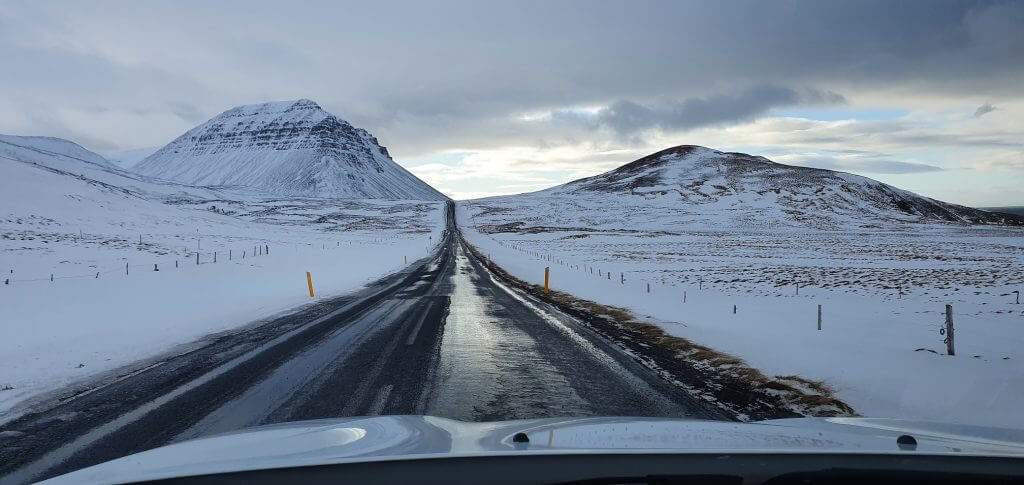
This is a well-maintained winter road without snow
What, however, can change the situation dramatically, is weather. If it rains, snows or there’s a strong wind, it is much more dangerous to drive on an icy or snowy road. You need to be more careful and experienced if this is the case. The only way how to be sure about this, is to slowly try all these conditions yourself. Observe very carefully and gradually what you are and what you are not capable to drive through. Most importantly, if feeling unsecure, better stop, wait or find a different road.
7.3. Driving times in winter
In summer, you can more or less rely on time estimates produced by Google Maps, or any similar GPS software. In winter, this is not the case at all. In fact, the opposite is the case. It always takes us longer to complete the drive in winter. For obvious reasons – snow, rain, wind. I suggest counting with roughly double the summer/normal times – if you insist on any estimates.
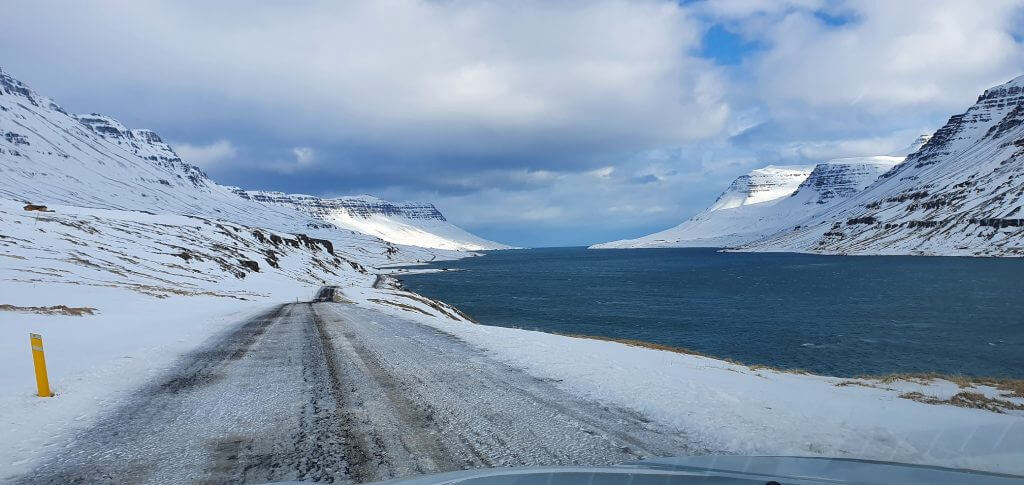
A typical winter road condition in Iceland – a little bit of ice, a little bit of snow
8. Car rental in winter
Do you need a 4wd car in winter in Iceland? Well, I always recommend taking at least a cheap 4wd car like Dacia Duster when traveling to Iceland in winter. You never know where and when you can get stuck in the snow. It may even be just at the car park. Here’s where 4wd comes handy. The longer you plan to stay in Iceland and the more you plan to go away just from the ring road, the more you need a 4wd car.
For majority of beautiful and accessible places in Iceland a simple 4wd car would be enough. If you plan to drive the less driven roads (e.g. the 3-digit roads or mountain passes, or the roads marked with black) the bigger 4wd car like Toyota Land Cruiser comes really handy. And as always – the bigger car you rent, the bigger the chance you will not get stuck!
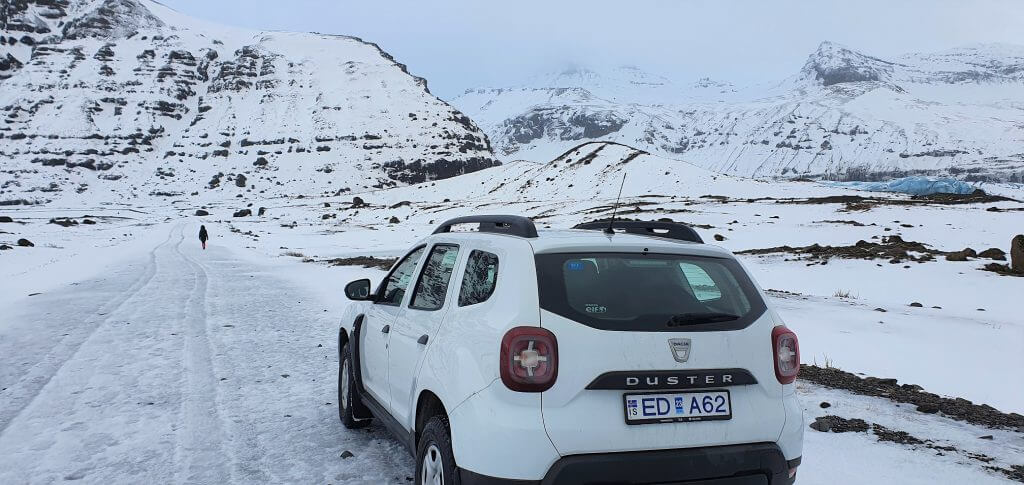
Road to Svínafellsjökull in winter
What about highlands, super jeeps and all these roads marked as “no winter service” or “impassable”? Technically, it’s not forbidden to drive them, we explain more about Icelandic roads being impassable here. BUT. You need a huge vehicle for it, let’s call it a super jeep, and a good local knowledge of the roads. This means – either team up with someone local or better book a super jeep tour.
8.1. Our winter car rental experience
We have already had a great experience with Go Car rental in summer, so we rented with them again in winter. We rented a 4wd Dacia Duster, the best price to value car for any ring road trips in my opinion. Our trip was scheduled for the last week of February and the first week of March. Dacia Duster is a great choice for simple F-roads in summer, for the entire ring road, and also for the majority of winter trips, because it is a 4wd car for a very affordable price. We write more about it in our guide on How to choose the best car for Iceland.
A PROMO CODE epic5 will get you a 5% discount with Go Car Rental and us a small commission at no extra cost to you.
Go Car rental already includes super collision damage waiver, gravel protection and theft protection in their rental prices. These are the insurances you’re gonna need the most in winter in Iceland. In most of the cases, you basically don’t have to do anything additional with the insurance anymore. If you want to fully understand how Icelandic car rental insurance works, we wrote a guide on Icelandic car rental insurance.
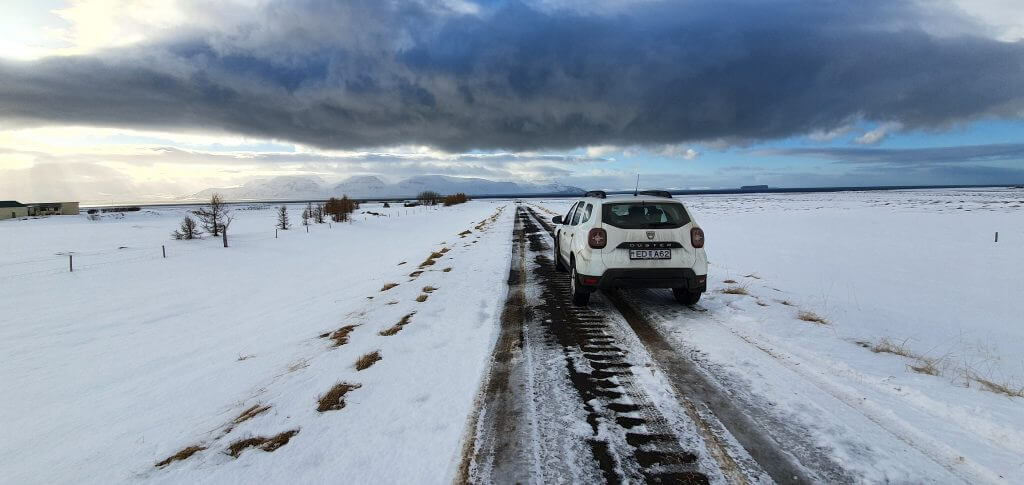
We strongly suggest to rent a 4wd car, at least a simple one.
Once again, we had a great and smooth experience with the rental from Go Car. They have an office located just a 5-minutes walk from the airport hall (right next to the Aurora airport hotel). No need to take expensive taxis or wait hours for a shuttle. We collected our car within 15 minutes, not waiting in their office at all. The staff just quickly explained to us some basic car rental rules and we were good to go. The (great) experience is very similar also with Lotus car rental and MyCar rental.
A PROMO CODE epicicelandd5 will get you a 5% discount with Lotus and us a small commission at no extra cost to you.
The car itself was a great choice. We didn’t have a single problem with our Duster. We got everywhere we needed and everything worked just as it should have. We had a huge luggage suitcase which fit right into the car trunk and all our backpacks and food could easily be stored on back seats. For 3 or more people I would recommend bigger car, though. Duster is the most popular choice in Iceland and for a reason.
A RARE PROMO CODE EPICICELAND will get you a 5% discount with MyCar and us a small commission at no extra cost to you.
Go Car Rental is not the only great car rental company in Iceland. We have used several times in the past also Lotus Car Rental and MyCar Rental. We can more than just recommend all these 3 companies. Lotus is special in Iceland, because they offer a full platinum insurance that insures absolutely everything, even F-roads and river crossings (in summer). MyCar offers the best customer service and rents brand new Toyota cars for affordable prices.
We offer to our readers a 5% PROMO CODE for Go Campers rental.
For Campervans we can more than just recommend two amazing companies with amazing service and reliable Campervans. Probably the most famous Icelandic Campervan company is Happy Campers. They have a base at Keflavik airport. Slightly less known, but equally great company are Go Campers. They have a base in Reykjavik city.
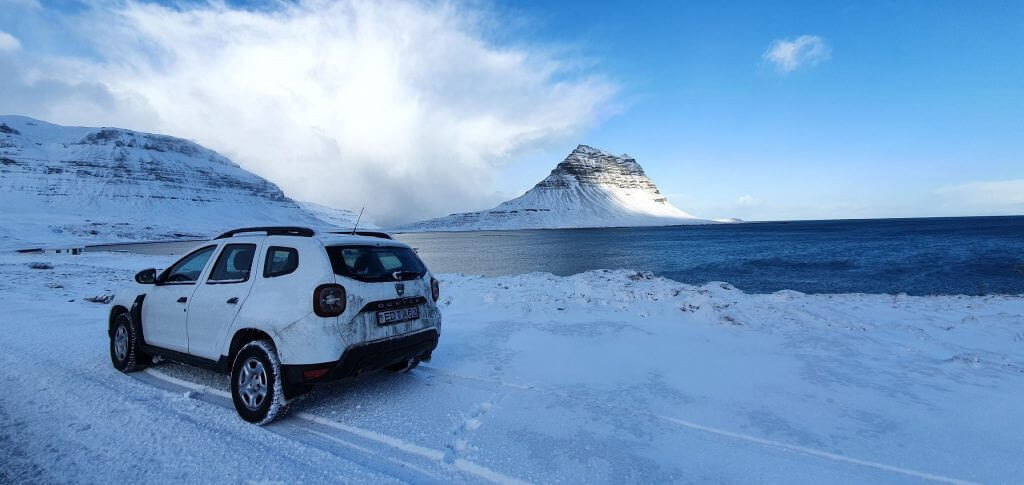
Dacia Duster is a very good 4wd price/value. It will not get you everywhere, though!
9. Flights to Iceland in winter
Flights to and from Iceland often get delayed in winter and sometimes even cancelled. All delays and cancellations are due to weather. For example, both of our February flights (inbound and outbound) were delayed. First one by 8 hours due to orange weather alert. Second one by 3 hours due to strong winds. Flight cancellations most of the time happen on intercontinental flights (flights from the US or Asia). Flights inside the Europe most of the time get just delayed.
10. Northern lights
How to see northern lights in Iceland? Where to see aurora in Iceland? When to see northern lights in Iceland? These are some pretty often googled questions. Yet, your googling may often bring confusing results. So, let’s get Northern Lights in Iceland straight. If you want to maximize your chances of seeing aurora in Iceland, I suggest you read our Detailed Guide on Northern Lights in Iceland, where we dive deeper into the topic. If you insist on a short answer then to see Northern Lights in Iceland, you need “only” 3 things:
- Dark skies
- Clear skies
- Aurora activity

Northern Lights show as witnessed at Aurora Viking guided tour
10.1. What are the best months to see Northern Lights in Iceland?
The shortest answer is between September and April. You need to balance good weather with dark skies. The best balance seems to be somewhere around September/October and then March/April. No guarantees, due to unpredictable weather. Also, I suggest you read our Full Northern Lights Guide article to understand what are your chances to see Northern Lights. A very very short summary is below:
Discounts on Best Aurora Guided Tours in Iceland
10.2. How to see Aurora in Iceland?
- Come when the days are dark (September to April)
- Come when the skies are clear (better chances in September, October, March, April)
- Center your visit around new moon phase
- Watch forecast for days with no clouds
- Watch forecast for high aurora activity
- Stay away from cities and light

Northern lights guided tour by Glaciers and Waterfalls, 10% discount code: EPICICELAND
11. Hiking in winter in Iceland
Firstly, expect majority of tougher hikes (like Fimmvörðuháls, or hikes in Landmannalaugar, Kerlingarfjöll, or Þakgil) to be impassable and closed to general public. This is true once the first real snow settles in the highlands, which usually happens beginning of October. The snow then remains in the highlands until May, June, or sometimes (2022) even July. These tougher hikes then re-open to visitors once the major snow-packs melt, i.e. usually sometimes in June. If you are unsure about a specific hike, please contact safetravel.is for reliable information.
Secondly, don’t worry, of course you can hike also in winter in Iceland. Just try to pick a shorter hike, an easier hike, and a day with good weather (no strong wind, rain, snow or fog). While we often recommend going “off the beaten path” in summer, we recommend totally the opposite in winter. Remote places in winter mean no traces of footsteps, deep snow and no help anywhere – avoid them.
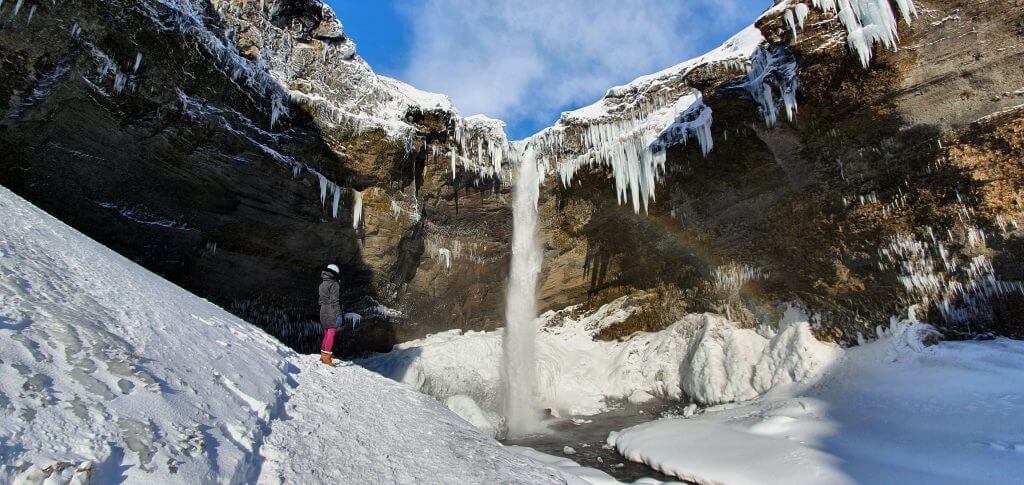
An easy hike to Kvernufoss in winter
Thirdly, buy spikes and wear them on your shoes! Spikes are totally invaluable for almost all winter hikes in Iceland. Winter hiking trails in Iceland are very often frozen, icy and slippery – you need a good grip and no winter shoes will guarantee that. Finally, similarly to driving times, expect your hiking times to roughly double. You will be hiking on an icy terrain and/or through snow and pretty often against wind. Such hikes are also much more strenuous, count on that.
12. Tourists
There are less tourists in Iceland in winter compared to summer (June, July, August and September). BUT. Winter is still a pretty popular time to visit Iceland, so don’t expect to be alone there. The typical touristy sights like a golden circle, silver circle and south coast can get pretty packed even in winter. That’s why we prefer visiting mostly places where tour buses don’t go, or where they go only seldom.
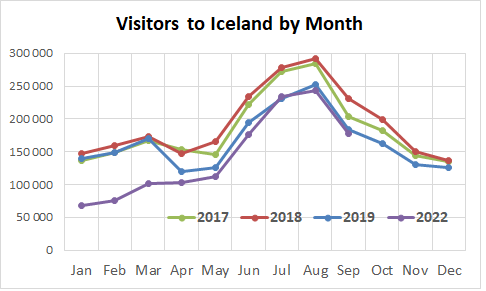
Visitors in Iceland by months
The busiest winter month is March, because the daylight is longer, Iceland still looks like a winter fairytale and there’s still a good chance to see northern lights. Prices are highest in March out of all winter months. March is then followed by February, January and November. The least visited winter month is December.
We prefer to visit Iceland in winter at the end of February, because the chances for northern lights are pretty good, the country is still covered in snow, the number of tourists is bearable and the daylight hours are sufficient. And as always, we try to avoid the most touristy places like Golden Circle. That being said, in winter it makes much more sense to visit also touristy places in Iceland. Why?

Reynisfjara beach can easily get crowded also in winter. This is one of the most touristy places in Iceland.
First of all, there will be less tourists compared to summer. Secondly, imagine hiking in a strong wind, sometimes rain and snow and a cold weather. You will more than just welcome all these “touristy infrastructure” places, where you may warm up a little bit, eat or drink something hot and just relax inside for a while.
Last but not least, it’s much safer to stay around more touristy spots in winter. Believe me, you don’t want to get stuck in snow somewhere alone, be it a road, a hike, or a remote accommodation. In summer, this is not much of an issue, but in winter it may be. That’s why we are strong advocates of remote places in summer, not that much in winter, though.

